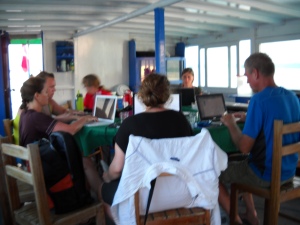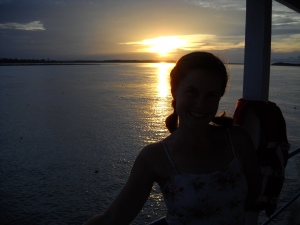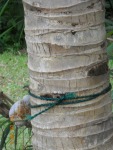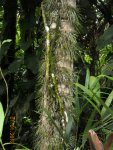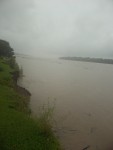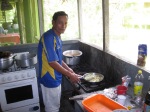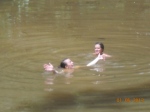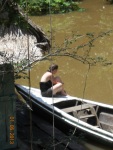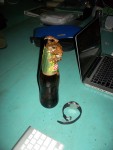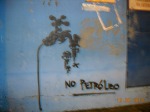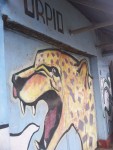January 1, 2013
Iquitos, Peru
The Professor enlightens
Today we had the opportunity to meet with a Professor of Ecology from the National University of Peruvian Amazon, Roberto Pezo. An extremely knowledgeable and patient man, Dr. Pezo answered many of our questions concerning petro activity in Peru, and spoke with us about general environmental challenges for the region. Here is what we learned from Dr. Pezo:
Petro exploration began in Peru in 1939, when geological observations suggested that oil was present. Oil shales in North and South Peru are only 5000 to 6000 feet deep, so extraction is relatively easy endeavor. However in the center of the basin that was long ago an inland sea, drilling must go as deep as 12,000 feet. In many areas, the groundwater is so “fluid” that it constantly fills voids as they are created, so submergable pumps must be used to pump water out of the wells, increasing production costs. Still, this oil is worth getting (at least in the minds of the petro companies that have invested in the effort). In fact, this is heavy crude being pulled off the top. Geologist estimate that oil reserves in Peru exist to 20,000 – 25,000 feet and are possibly equal to those in the Gulf of Mexico. Its clear that petro extraction has a potentially long future in Peru.
So, why should we care?
Because much of this oil feeds the insatiable appetites of the United States and other developed countries, and petro extraction is not without impacts, as we have learned.
These are social and environmental, and I will describe the issues in greater detail in following posts. There is an incredible amount of money at stake. While some proceeds from the petro are reinvested into communities throughout Peru, this return is relatively insignificant (later I learn exactly how insignificant) and not worth the potential losses. As Dr. Pezo explained, the people in the communities that are affected by the oil exploration and extraction have no experience in negotiating with big companies like Conoco-Phillips or Talisman or Pan America Energy. NGO’s often step in to “help” but sadly don’t always have the best interest of the community in mind. In one instance, the negotiation resulted in a monthly payment to the community of $10,000 soles. The money was divided among individuals who lost incentive to work and the community actually suffered.
Intangible (untouchable)
A 2008 research paper, “Oil and Gas Projects in the western Amazon: Threats to Wilderness, Biodiversity, and Indigenous Peoples”, by Finer, Jenkins, Pimm, Keane, and Ross, describes the status of oil and natural gas activity in the Western Amazon watershed. How it works is that governments designate “blocks” of area that can be leased to international petro companies for exploration and extraction. An alarmingly large area of the western Amazon, including area in Peru, Ecuador, Columbia, Brazil, and Bolivia, is designated into blocks. These blocks presently cover 688,000 km2 in the western Amazon and are operated by at least 35 multinational oil and gas companies. In Peru, these blocks cover about 72% of the Amazon region. Many of these blocks overlap areas that have been designated protected, or “Zona Intangible” (untouchable zone) due to high biodiversity or the presence of “indigenous groups in voluntary isolation” (Finer, et. al, 2008).
A new model
There are better ways. Dr. Pezo described a new model in place in a community on the Curaray River, just south of the Ecuador border, that was suggested as part of an Environmental Impact Study. It provides training to people in affected communities to be environmental monitors to help keep watch on the activities of the petro company, making sure they are following regulations. Another model in place is six month training for community leaders in negotiating skills and community development projects. The oil companies provide this training, as well as technical experts to act as consultants and provide support. Scholarships are offered to students to go to college, provided they will return to the community with leadership and community development skills.
Beyond petroleum (And I don’t mean BP, the company)
Many other environmental concerns exist beyond those associated with petroleum extraction. Dr. Pezo describes his worry over a proposal to develop a 40,000 hectare of African Palm trees (Elaeis guineensis) on the Nanay River. Aside from the fact that they rain forest will be cleared to install a non-native monoculture, the palms cannot grow well without constant input of agrochemicals, which wash into rivers during high rainfall. Often such plantations are abandoned soon after establishment because they are expensive to maintain, and the rain forest soil cannot support such crops.
Much like the weather extremes we are observing in the United States, Iquitos and greater Loreto are experiencing extremes too. From 1904 (when record keeping began) to the 1970’s, the river (Amazon and tributaries) followed a consistent pattern of rise and fall. Last year, the river hit a record high, followed by a record low this year. This change coincides with deforestation of the high forest on the east side of the Andes. The high forest regulates water, slowing it down as it moves through the water shed. There is not necessarily more or less water in the years of high and low records; it just isn’t naturally regulated. The high forest provides this ecosystem service, invaluable to the people that live and work on the river.
As with many places around the planet, Peruvian scientists are observing differences in flowering and fruiting phenology of some flora, possibly due to climate change. Rather than the temperature changes we are experiencing in the U.S., the Amazon region is experiencing humidity changes, particularly in the eastern Amazon, where deforestation results in decrease in humidity (estimated 5%).
Next steps for sustainable development.
Dr Pezo comes to the same conclusion as me and sustainabilistas around the world: before we can begin to live, work, and learn more sustainably, social issues must be addressed. It all depends on changing the mindset of people.
Economic generators in Iquitos, Peru:
- Oil and gas exploration
- Timber removal and exportation (primarily to Asia)
- Regional government (Iquitos capital city of Loreto)
- Narcotic trafficking
- Aquaculture – food fish and tropical fish (although tropical fish exports have reduced due to increase of this activity in China)


